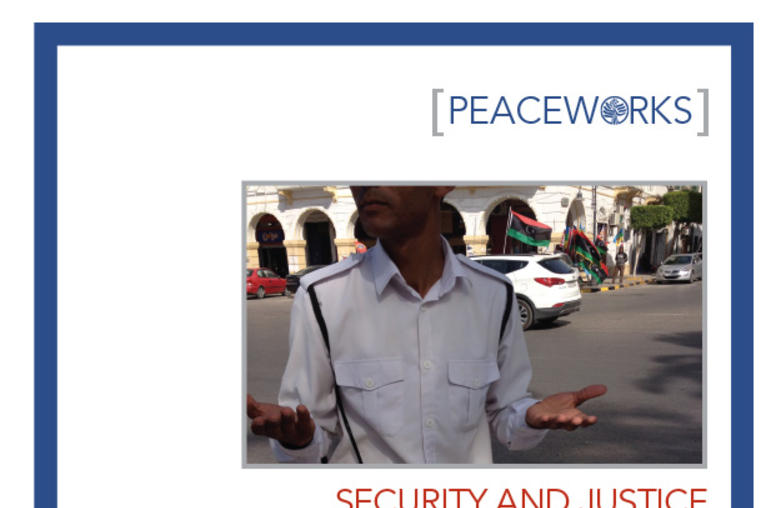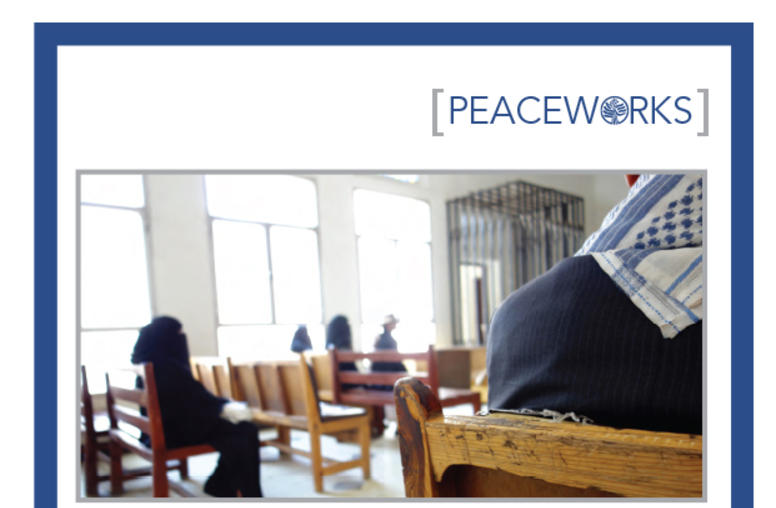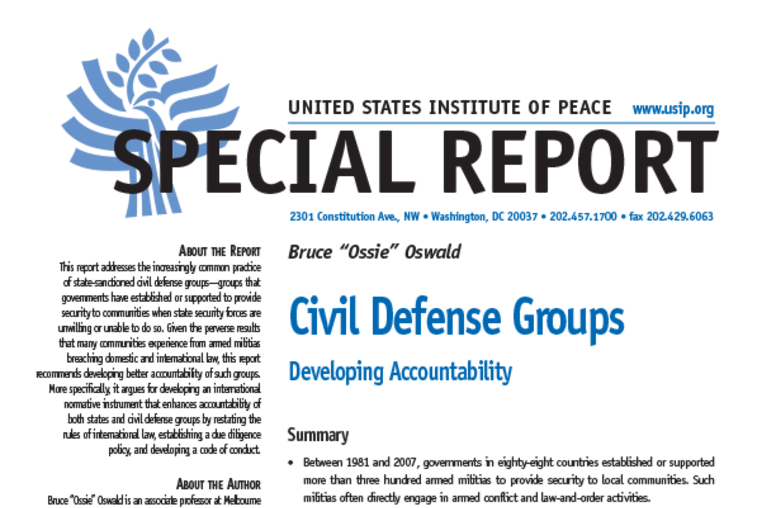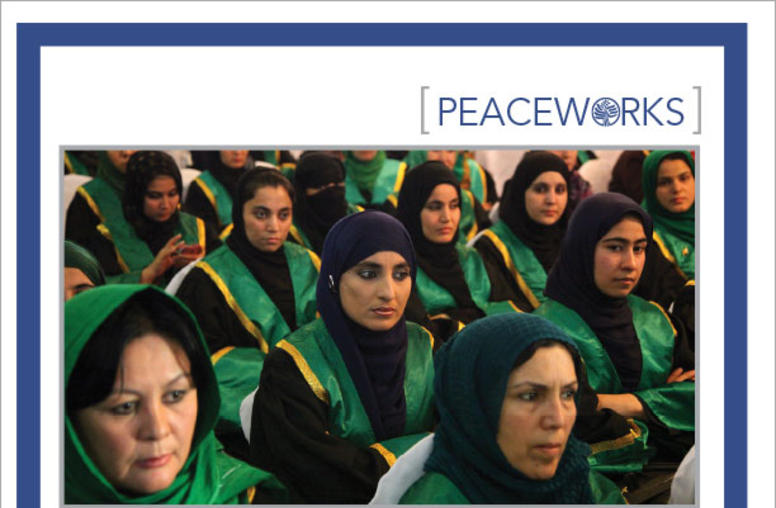USIP reports from Nicaragua on how people continue to struggle with the civil war of the 1980s.
Posted: December 16, 2009
By Colette Rausch, Lelia Mooney and Suzanne Wopperer
Introduction
By Colette Rausch
In November, Lelia Mooney and I flew from Washington, D.C., to Nicaragua armed with audio and video recorders and a plan to capture the human dimension of the country’s conflict. We met up with Suzanne Wopperer, a USIP alum who has been living in Nicaragua for the past five years. The three of us then spent ten days traveling through the country as part of an ongoing project called "Voices from the Field: Rule of Law through the Eyes of the People." The Voices project gathers personal stories of people, young and old, from around the world who have lived through war and are dealing with its aftermath. Members of the Voices team had already been to Nepal and Kosovo. Future destinations include Afghanistan, Haiti, Iraq, Liberia, Peru, and Sudan.
People interviewed for the Voices project range from taxi drivers to human rights activists, government ministers to peacekeepers, judges to jailers, United Nations personnel to rebel soldiers. Interviewees include members of all sides of a conflict, without regard to their political affiliations and their pro- or anti-government credentials. The interviews are conducted like conversations, and the informality encourages people to tell their personal--and often painful--narratives of conflict, to comment on their country's current security situation, to explain what the rule of law means to them, and to share their hopes for the future. Oftentimes, those who are interviewed, as well as those who conduct the interviews, come away with a profound sense of honor: of being heard and of bearing witness, respectively.
- Historical Context: “Animal Farm All over Again”?
- Managua: Women Speak Out
- Leon: A Thanksgiving in the Birthplace of Revolution
- Jinotega: Counterrevolutionaries Reflect
- Managua: Hugo Chavez in Town
Historical Context: "Animal Farm All over Again"?
By Colette Rausch
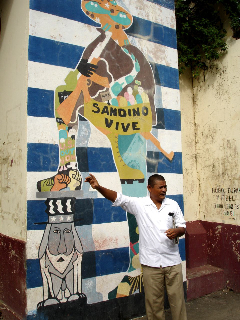 Our route through Nicaragua followed the same path carved by recent conflicts in the country. We started our journey in the nation’s capital, Managua, home to a long chain of authoritarian governments. From there we ventured to Leon, the epicenter of just about every conflict the nation has faced and a hotbed of support for the Sandinistas, socialists who overthrew one dictatorship but who also have been accused of seeking to establish their own.
Our route through Nicaragua followed the same path carved by recent conflicts in the country. We started our journey in the nation’s capital, Managua, home to a long chain of authoritarian governments. From there we ventured to Leon, the epicenter of just about every conflict the nation has faced and a hotbed of support for the Sandinistas, socialists who overthrew one dictatorship but who also have been accused of seeking to establish their own.
Then, just as the conflict took to the mountains in the north, so did we; traveling to Jinotega and San Rafael del Norte, where many people sympathize with the Contras, the U.S.-funded guerrillas who fought the Sandinistas in the 1980s and whose ideological heirs battle them today at the ballot box.
In a country where the past is intensely alive, we realized we needed to learn some history before we set off.
The Pacific coast of what is today Nicaragua became a Spanish colony in the early 16th century. Not until some 300 years later, in 1838, did Nicaragua attain the status of an independent republic. The Caribbean coast was controlled in the 17th and 18th centuries by Great Britain, which occupied it in the first half of the 19th century before finally ceding control to Nicaragua in 1860.
In 1909, U.S. troops helped depose a dictatorship in Nicaragua. Three years later, U.S. marines occupied Nicaragua. Except for a brief hiatus, they remained there until 1933. From 1927 to 1933, Augusto Cesar Sandino led a rebellion against the U.S. military presence; his legacy and name were later claimed by the Sandinistas, because he was seen as a symbol of challenging U.S. domination of Nicaragua.
For much of the 20th century, Nicaragua was subjected to dictatorial regimes under the control of the influential Somoza family. In the 1970s, however, the Somoza government’s National Guard found itself increasingly challenged by the insurrectionary Sandinista National Liberation Front (FSLN). In 1978, violence escalated into civil war, which the Sandinistas and their allies quickly won.
When the Sandinistas took power in 1979, however, many Nicaraguans began to suspect that the new government was just another variation on the country’s authoritarian tradition.
The 1980s saw Nicaragua become a battlefield in the wider Cold War as East and West funded a war between the Sandinistas and the Contras (short for the Spanish word contra-revolucionarios--“counterrevolutionaries”). The United States provided aid to the Contras, some of whom had been members of Somoza’s National Guard. Other Contras, however, had fought alongside the Sandinistas but by the early 1980s had become increasingly disenchanted with the new regime. The Soviet Union and Cuba supplied aid to the Sandinista government, which in turn funneled arms to a left-leaning insurrectionary movement in El Salvador.
The civil war was ended by a peace agreement signed in 1989. Elections the following year saw the defeat of the Sandinistas by a coalition of left and right parties. Violeta Chamorro, whose husband had been assassinated by the Somoza government in 1978, led a unification party and became president. Her platform emphasized the peace process, national dialogue, and reconciliation.
In 2006, the Sandinistas returned to power with the election of Daniel Ortega, who won the presidency with just enough votes to avoid a runoff.
In the past few years, allegations of electoral fraud, harassment of nongovernmental organizations and human rights activists, and efforts to amend the constitution to let the president run again in 2011, have tarnished Ortega’s democratic credentials. Nicaraguan Catholic Bishops have accused the government of "reopening deep wounds" from the 1980s. As international donors discuss withdrawing from the country, many people inside and outside Nicaragua fear that Ortega’s rule is becoming increasingly dictatorial. To them, it seems a classic case of the oppressed becoming the oppressor, or--as the Independent newspaper put it, "Animal Farm all over again."
Managua: Women Speak Out
By Lelia Mooney
Against this troubling political backdrop, we kicked off our ten-day odyssey with three days of interviews with representatives from civil society, think tanks, the media, and the judiciary. These people spoke eloquently about the challenges they faced during the armed conflict between the Sandinistas and the Contras. They also described how their past experiences resonate with today’s challenges to the rule of law in Nicaragua.
The Managua meetings (as well as the ones in Leon and Jinotega) brought to the fore a dimension of conflict that tends to be overlooked in many explorations of countries trying to build peace in the aftermath of war and the shadow of authoritarianism: gender. Our interviews for the "Voices" project included conversations with women who had fought on the front lines during the civil war as well as those who had held high rank in the army. We even chatted with a female doctor who had worked alongside Soviet surgeons operating on badly wounded fighters in combat zones. We learned about mothers who had lost their children to the war and women who had lost their youth to the war. One woman we met, who had lost her leg in the fighting, described her daily struggles to remain loyal to her political ideals while eking out a living.
Our stay in Managua coincided with the International Day for Elimination of Violence against Women, a day that did not go unnoticed in a country that suffers from high levels of gender-based violence and domestic violence. As our taxi took us from one meeting to the next one, we saw groups of women marching along the capital’s wide and dusty avenues on a hot and humid day to demand respect for a woman’s right to be a full member of a peaceful society where everybody is treated equally under the law.
Leon: A Thanksgiving in the Birthplace of Revolution
By Colette Rausch
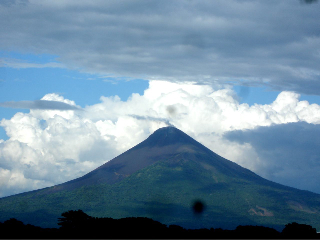 After our last meeting in Managua, we packed up and climbed in the taxi – a very small taxi -- that would take us on a 90-minute drive northwest to Leon and the volcanic lowlands of Nicaragua. It is here that virtually all of the country’s rebellions and wars have originated--hence its nickname, "Nicaragua’s hotbed of revolution." Our taxi driver, a former Sandinista from Leon, came highly recommended. We figured his stories would more than make up for his car’s lack of shocks and air conditioning (the latter hardly a luxury in a cramped taxi heading to the driest and hottest part of a tropical country). With all of us and all our equipment piled in the back, the shock-less car made a disturbing crunching sound every time it went over a bump. But this too had its compensation, because it prompted our driver to tootle along at a comfortably safe speed, allowing us to snap photos of passing ox-carts and the many volcanoes that lined our route. We saw Volcán Mombotombo smoking in the distance and learned how the original city of Leon was completely buried by ash in 1610.
After our last meeting in Managua, we packed up and climbed in the taxi – a very small taxi -- that would take us on a 90-minute drive northwest to Leon and the volcanic lowlands of Nicaragua. It is here that virtually all of the country’s rebellions and wars have originated--hence its nickname, "Nicaragua’s hotbed of revolution." Our taxi driver, a former Sandinista from Leon, came highly recommended. We figured his stories would more than make up for his car’s lack of shocks and air conditioning (the latter hardly a luxury in a cramped taxi heading to the driest and hottest part of a tropical country). With all of us and all our equipment piled in the back, the shock-less car made a disturbing crunching sound every time it went over a bump. But this too had its compensation, because it prompted our driver to tootle along at a comfortably safe speed, allowing us to snap photos of passing ox-carts and the many volcanoes that lined our route. We saw Volcán Mombotombo smoking in the distance and learned how the original city of Leon was completely buried by ash in 1610.
We also talked of the stories told by both sides of the war about combatants forced into service. One such unfortunate fellow was abducted three times by the Sandinistas before they finally managed to force him into service. During his second abduction, he was loaded onto a bus with other recent "recruits" headed to the front. When the bus stopped for a brief interval, he and another unwilling compadre fled their captors under gunfire. Although the two successfully evaded capture on that occasion, the third time he was not as lucky, and he was finally brought to the front lines for war. His brother, too, had met a similar fate, except that his brother had been forced to join the opposing side.
One night, while manning his mortar position, he got word that a pair of Contras had crossed the front line to bring him the news that his brother had triggered a landmine and lay mortally wounded not far from his position. Upon learning the news, the mortar man crossed the battlefield with the opposing fighters, reaching his brother just in time to console him before he died. The experience was so traumatic for the reluctant soldier that he vowed to leave Nicaragua and never to return. Today he lives in Washington, D.C.
Upon our arrival to Leon, we came across an old but refurbished neo-classical-style hotel, ideal for our interviews. As is traditional with colonial era construction, the hotel encloses a charming inner courtyard with a lush garden and a fountain at its center, encircled by a covered patio. After we settled in and commandeered a secluded area of the patio to use as our impromptu office, we sat down to discuss our interview schedule.
Jim, one of the proprietors, came up and introduced himself. We learned that he was from Wisconsin and that his business partner, Mark, was a former lawyer from Alabama. He also announced that the hotel would be serving a traditional Thanksgiving dinner that evening. Being so far from home, we were all excited to enjoy a bit of an American holiday tradition that evening.
The next day, on Jim’s recommendation, we met with Julio, a reluctant insurgent in the conflict with Somoza. Julio not only related the turbulent history of Leon--from the arrival of the Spanish conquistadores, through numerous conflicts, to the worrying present--but also told us about his own experiences during the back-to-back conflicts. He recalled how, when he was 13 years old and on his way home after playing baseball, he and his playmates were grabbed by a unit of Somoza’s National Guard, who, seeing the boys’ dirty uniforms and scrapes, suspected that they were associated with the Sandinista guerrillas. The boys were tortured, locked in caskets for up to four days, and had their heads flushed in filthy toilets. Food sent to them by their families was spat on by their guards. Actual guerrillas consoled their tears with stories of the revolution. After three months, Julio was released with the help of Red Cross Canada, who inspired him to learn English. It was only after the harsh mistreatment he received in jail that Julio willingly joined the ranks of the Sandinistas and went to the mountains to fight. Weapons were scarce, however, and Julio was young, so rather than being taught to shoot, he was given the job of creeping down to nearby villages to ask for or, if necessary, steal food and clothing. He and his compadres often found packages waiting for them.
Our original plan was to head out the next day for Jinotega, but one of our group fell ill, so we decided to stay another night. Having paid a visit to USIP’s Web site and been impressed with the Institute’s mission and work, Jim offered to help set up an interview for us with a former Sandinista fighter named Enmanuel who had lost both hands during an ambush by a unit of Somoza’s National Guard. Enmanual, dexterous with his prosthetic hands, now works with a nongovernmental organization that provides services for disabled people. We also called Julio for help and he introduced us to Rosa, another former Sandinista combatant and still an ardent supporter of the movement. She had lost one of her legs in combat. It struck our team that those we were meeting were much the same age as ourselves. Two of us were in our mid-to late forties, as were Rosa and Enmanual. While we were learning about the conflict in school, Rosa and Enmanual were living it.
So, thanks to our bedridden group member and the need to adapt our original plans, we ended up meeting people whose stories of survival made us reflect on our own – far more peaceful and comfortable--lives, giving us more reason to celebrate Thanksgiving.
Jinotega: Counterrevolutionaries Reflect
By Suzanne Wopperer
We next ventured from the warm coastal lowlands to the significantly cooler altitudes of Jinotega. It was here that much of the guerrilla warfare took place between the Sandinistas and the Contras in the 1980s. Perhaps coincidentally, much of the fighting in the 1920s between U.S. Marines and the forces of Augusto Cesar Sandino also occurred in this breathtaking region of high peaks, undulating valleys, and deep crevices; an area rich in water, coffee plantations, and old-growth forest.
As we headed north, we talked about Nicaragua’s history; internationally supported efforts to clear the landmines that still litter the area; the floods caused by Hurricane Mitch and the mines they had dislodged; USIP’s four grants given to Nicaraguans in the early 1990s when the government was interested in postwar combatant reintegration and national reconciliation; the nutritional balance of arroz y frijoles (rice and beans); the efficiency of the nearby hydroelectric plant; and how long it took several diverted rivers to fill the man-made Lake Apanas, a Ramsar Convention-protected watershed which rims Yuca Puca peak, where Sandino fought against the U.S. Marines.
We saw Yuca Puca only at a distance and because we had appointments with some former members of La Resistencia--as the Contras described themselves in the late 1980s. A car trip a la vuelta! ("just around the corner") -- that took us on a bumpy, off-road, hour-long drive avoiding pot holes, cowboys, and cattle – allowed us to see the Catholic Church at Tepeyác from afar. The local priest, candidate-for-canonization Padre d’Andrea Odorico, reportedly stopped a firefight to hold a mass, and the informal ceasefire was honored while Sandinistas and the Contras shared mass in the open air.
When we arrived in San Rafael Del Norte, we met with chele (fair-haired, light-eyed) as well as mestizo (mixed indigenous and European descent) ex-Contras. They had survived the fighting, weathered the process of combatant reintegration in the 1990s, and dealt with the stigma that accompanies the state of being among those who lost--relatively speaking--the war. They were just as honored by USIP’s interest in their perspectives as the Sandinistas and former Sandinistas we had met in the preceding days. One coffee farmer, who attested to having "not a drop of military blood in my bloodline," had been captured and conscripted into service by both parties and twice by one of them. On one occasion, the Contras and Sandinistas had converged in battle on the very same farm where we were now chatting, all demanding food, water, and allegiance. His Honduran wife, who he met during a crossborder retreat after a skirmish with the Sandinistas, offered us toasted corn tortillas with cuajada, a delightful local creamy cheese. We visited his cardamom plants and coffee processing plant, a well-appointed arrangement of de-pulping and drying installations. We collected a variety of lemons, including some huge and deformed “beer lemons,” closest in flavor to the lemons found in the United States, so that the seeds could be planted in an organic farm to the south that we also visited to get a quick lesson in subjects such as water cultivation and permaculture.
We drove back down the bumpy road and--after getting and quickly fixing a flat tire -- met with a dignified ex-Contra commander. His deepest regret was that, during the civil war, his mother had inspected the caskets of many dead Contra leaders to see if one of them might be her son. This grim and regular routine, he suspected, may have brought her an untimely death. Her photos framed his room; in some she was young and vibrant, in others, elderly and hollow-eyed.
Managua: Hugo Chavez in Town
By: Colette Rausch
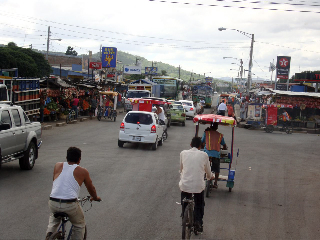 We left Jinotega and headed back to where we had begun: Managua. Riding the cheapest and most popular form of transportation, the local bus, we left the coolness of Jinotega and crawled toward the capital and its sweltering heat. Over the course of four hours, the bus took us from lush jungle mountain landscapes into dry desert shrub plains, passing countless cows, horses, roadside vegetable stands, mule-drawn carts, and human-powered rickshaws along the way.
We left Jinotega and headed back to where we had begun: Managua. Riding the cheapest and most popular form of transportation, the local bus, we left the coolness of Jinotega and crawled toward the capital and its sweltering heat. Over the course of four hours, the bus took us from lush jungle mountain landscapes into dry desert shrub plains, passing countless cows, horses, roadside vegetable stands, mule-drawn carts, and human-powered rickshaws along the way.
After we arrived at our hotel, we decided to spend our final hours in Nicaragua collecting video footage of Managua for the Voices project. Our taxi driver offered to take us to a barrio he thought we’d find interesting. He drove to a dusty intersection and gestured toward an arched sign emblazoned with "Welcome to Barrio Hugo Chavez" with an impoverished neighborhood beyond. We were surprised to hear from our taxi driver that the Venezuelan president had inaugurated the neighborhood and visits it each time he travels to Nicaragua. Apparently, Chavez adopts impoverished neighborhoods in various parts of Latin America and gives them financial support.
After exhausting our videotape, we went back to the hotel and packed our bags. We were leaving Nicaragua with something far more valuable than anything we had brought. We were heading home with a real treasure: the reflections of people who had had to struggle for survival and yet who, each in his or her own way, had tried to build what they believed would be a brighter future for their country.
Departing Nicaragua, I was struck by something that differed from the feelings and thoughts I had upon leaving Kosovo and Nepal. In Nicaragua, I sensed a tired nation. Tired of conflict, tired of fighting each other and tired of a succession of self-interested governments. There seemed to be a resignation to their lot in life.
But there was one theme that all three countries shared. It was the frustration of their youth. In each country, the youth we interviewed were vocally angry and dissatisfied with the status quo. I listened to their views that perhaps only a revolution would make things better. I wondered, was this youthful activism expressing itself or is it the seeds of another cycle of violence taking root? It made me reflect upon the need to identify possible roles of the younger generation in strengthening rule of law to prevent future conflict.
